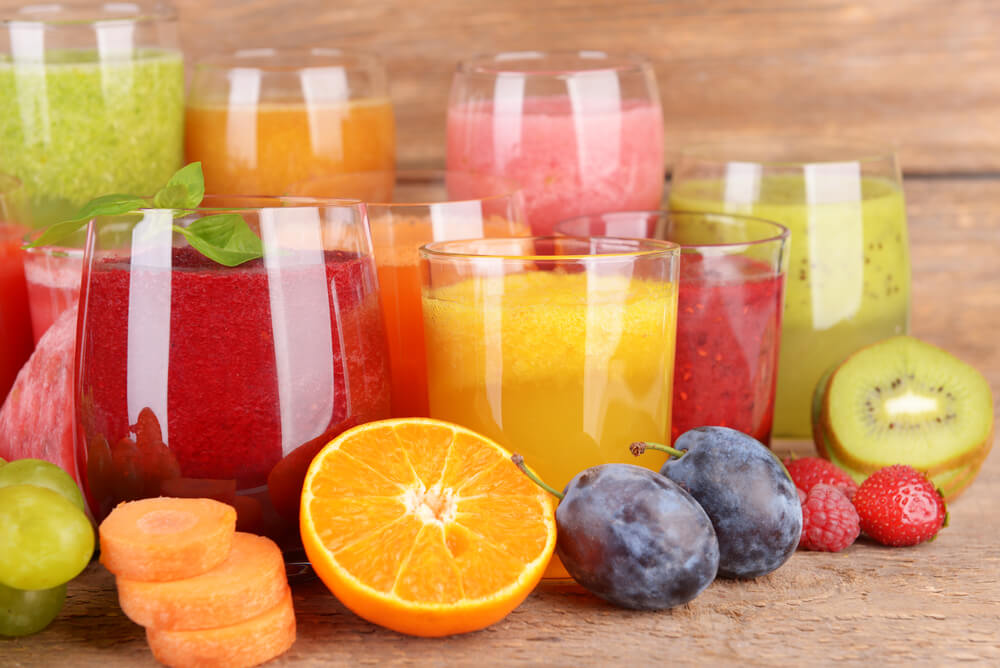
#10 Fruit Juices
Even though fruit juices contain some vitamins, they also have too many calories and sugar. The minor amounts of antioxidants and vitamins that are in fruit juices do not make up for the high sugar totals. For example, one 8-ounce glass of grape juice has about 170 calories, 40 grams of sugar and 42 grams of carbs. That is more sugar and calories than a 12-ounce can of Coca-Cola. That’s a lot of empty calories and sugars. Skip it!
Juices labeled all natural may contain additives and high-fructose corn syrup. Fruit juice can be a little deceiving. They are often perceived as healthy and labeled as “not from concentrate” or “100% pure.” Fruit juice is high in sugar and contains no fiber. The flavor has been removed after going through the processing method. Then, flavor packs are added back into the juice to bring them back to their original state. Try to stay away from them.
How Do You Know What Is Healthy?
Reading a nutrition facts label is fairly simple. Once you understand it, it will be easier to make quick and informed food choices to maintain a healthy diet.
The info shown in the top section of the label contains product-specific data. This includes serving size, number of calories and nutrient info. The bottom section has a footnote of the Daily Values for a 2,000-calorie diet. The footnote provides the recommended dietary info for important nutrients. This includes fats, fiber and sodium. The very top of the label shows the serving size and number of servings that are in the package.
Calories are also listed on the label. They are a measure of the amount of energy you get from one serving of that particular food item. This section can help you manage your weight.
What Are The Nutrients Listed?
The top of the nutrient section will show you some key nutrients and that’s separated into two groups. The nutrients that are listed first are the ones people eat in adequate amounts. Eating too much cholesterol, fat, saturated fat, trans fat or sodium can increase your risk of certain diseases such as high blood pressure, heart disease or some cancers. You will want to keep your intake as low as possible for a nutritionally balanced diet.
The nutrients listed next are the ones most people don’t get enough of. These include vitamin A, vitamin C, dietary fiber, iron and calcium. You can improve your health and reduce the risk of some conditions and diseases by consuming these.
The footnote shown on the bottom of the nutrition facts label will have an asterisk after the heading “% DVs are based on a 2,000 calorie diet.” This quote must be listed on all food labels. The % Daily Values (%DV) is based on the recommendations for key nutrients for a 2,000-calorie daily diet. A 5%DV or less is low. A 20%DV or more is high. Protein, trans fats, and sugars are nutrients that do not have a listed advised %DV on the label.
The Order On The Label
When checking the ingredient list on food products, the first item listed is what the product contains the most of. For example, if sugar is listed near the top of the list, it means there is a lot of sugar in the product. But, if it is listed towards the bottom of the list, it means there is little sugar in the product. Pick that one!
Sugar is often called different names, so look for that! High fructose corn syrup, corn syrup, dextrose, maltose, sucrose, maple syrup, honey and fruit juice concentrate are other names for added sugars.

Conclusion
Avoid the 10 foods on this list! The best thing you can do is always read the nutrition facts label and ingredient list when buying any food item. That way you can make sure you are buying truly healthy foods. Remember: Just because a food item is in the healthy food aisle, that doesn’t mean it is healthy. Take the time to compare foods to see which ones are actually healthy for you.
By Pat King
Latest posts by Terry M (see all)
- Garage Gyms - Aug 1, 2018
- Kettlebells – Why They Should Be Added To Your Routine. - Jul 24, 2018
- Weight Belts: What Are They Really For? - May 31, 2018










[…] By Terry Asher […]